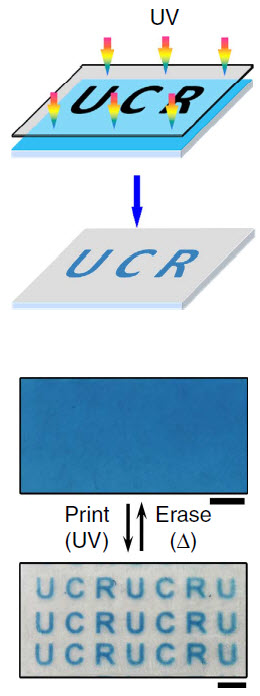Rewritable paper
December 4, 2014

Yadong Yin’s lab at the University of California, Riverside has fabricated novel rewritable paper based on the color-switching property of commercial chemicals called redox dyes. (Credit: Yin Lab, UC Riverside)
Chemists at the University of California, Riverside (UCR) have fabricated a novel rewritable “paper” process in the lab, based on the color-switching property of commercially available chemicals called redox dyes.
Printing is achieved by using ultraviolet light to photobleach the dye, except the masked portions for the text on the paper. The prototype rewritable paper can be erased and written on more than 20 times with no significant loss in contrast or resolution.
The rewritable paper does not require additional inks for printing, “making it both economically and environmentally viable,” said Yadong Yin, a UCR professor of chemistry, whose lab led the research. “It represents an attractive alternative to regular paper in meeting the increasing global needs for sustainability and environmental conservation.”
The process eliminates waste of paper (and ink cartridges) and the accompanying environmental problems such as deforestation and chemical pollution to air, water and land.

Schematic representations. Top: writing letters on the rewritable paper using a photomask on UV light irradiation. Bottom: printing letters (using UV) and erasing them (using heat). Scale bars: 5 mm. (Credit: Wenshou Wang et al./Nature Communications).
How it works
The rewritable paper is the form of glass or plastic film to which letters and patterns can be repeatedly printed, retained for days, and then erased by simple heating.
The paper comes in three primary colors: blue, red and green, produced by using the commercial redox dyes methylene blue, neutral red and acid green, respectively. Included in the dye are titania nanocrystals (these serve as catalysts) and the thickening agent hydrogen cellulose (HEC). The combination of the dye, catalysts, and HEC lends high reversibility and repeatability to the film, the researchers explain.
During the writing phase, ultraviolet light reduces the dye to its colorless state. During the erasing phase, re-oxidation of the reduced dye recovers the original color by reacting with ambient oxygen. Heating at 115 C can speed up the reaction so that the erasing process is often completed in less than 10 minutes.
“The printed letters remain legible with high resolution at ambient conditions for more than three days — long enough for practical applications such as reading newspapers,” Yin said. “Our rewritable paper is simple to make, has low production cost, low toxicity, and low energy consumption.”
Future commercial versions
His lab is currently working on an actual paper version. “Heating to 115 C poses no problem,” Yin said. “In conventional laser printers, paper is already heated to 200 C in order to get toner particles to bond to the paper surface.”
But don’t except to see this in Office Max soon. “It might take another ~3 years to make this into a commercial product,” Yin told KurzweilAI in an email interview. “Considering the fact that these materials are commercially available at low cost, I would expect the end-user cost would be close to that of conventional paper.”
To reduce overall cost, his lab is also working on increasing the cycling number (the number of times the rewritable paper can be printed and erased), with a target of 100. And the research team is exploring ways to extend the legibility of the printed texts or images for more than three days to expand their potential uses. “One way is to develop new photocatalyst nanoparticles that become highly reductive when irradiated by ultraviolet light,” Yin said.
The researchers are also exploring the possibility of multi-color printing, using various commercial redox dyes and light at different wavelengths.
The research was reported Dec. 2 in Nature Communications and funded by a grant to Yin from the U.S. Department of Energy. A provisional patent has been filed and the UCR Office of Technology Commercialization is actively seeking a company to license the technology.
UCR | Chemists at the University of California, Riverside fabricate novel rewritable paper
Abstract of Photocatalytic colour switching of redox dyes for ink-free light-printable rewritable paper
The invention of paper as writing materials has greatly contributed to the development and spread of civilization. However, its large-scale production and usage have also brought significant environment and sustainability problems to modern society. To reduce paper production and consumption, it is highly desirable to develop alternative rewritable media that can be used multiple times. Herein we report the fabrication of a rewritable paper based on colour switching of commercial redox dyes using titanium oxide-assisted photocatalytic reactions. The resulting paper does not require additional inks and can be efficiently printed using ultraviolet light and erased by heating over 20 cycles without significant loss in contrast and resolution. The legibility of prints can retain over several days. We believe this rewritable paper represents an attractive alternative to regular paper in meeting the increasing global needs for sustainability and environmental protection.